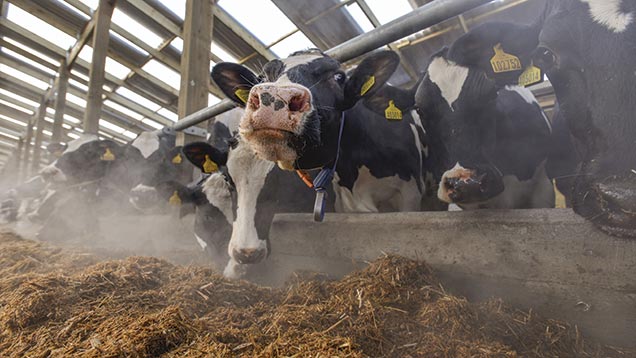How a Dorset dairy farmer has improved yields and solids
 © John Eveson/Rex
© John Eveson/Rex Producing gallons of “white water” may no longer be the best way to achieve the greatest returns, with some milk buyers moving towards a payment structure that rewards solids.
Moving to a constituent-based contract could be one way to increase revenue in the current climate of challenging milk prices, but getting the most out of it will require changes to cow management to improve both yields and quality.
In recent years, improving quality as well as yields has been a key priority for farm manager Anthony Butler and Arthur Crutchley, who run the dairy at Critchley Farms, Bridport, West Dorset.
Ration
But in 2015, getting this right will be even more important, as the farm has switched to an Arla contract, based on a more constituent-based pricing formula.
To help achieve this, they sought advice from Kite Consulting’s Mike Bray, who advised them to move towards a lower protein ration, while boosting levels of starch from 17%.
Critchley Farms
- Milking 350 cows three times a day
- Averaging 10,700 litres a cow a year
- Feed costs:
- Was £4.90 a cow a day achieving 30 litres (16.33p/litre)
- Now £4.64 a cow a day achieving 36 litres (12.89p/litre)
“We now feed a diet with 25% starch and have dropped protein back to 18% (from 19%),” explains Mr Butler.
“Historically half our forage has been from home-grown maize, and we now supplement this with bought-in milled maize to boost starch levels.
“When we changed our forager last year we went for a processor that breaks the maize up much more too, releasing extra starch, which has had noticeable effect on yield,” he adds.
Whole crop straw is used as the main fibre structure to support the bypass starch of milled maize, and they use live yeast to help with digestibility.
Results
Cows are now averaging 36 litres/day, up from 31 litres a year ago to take annual averages up to around 10,700 litres a cow.
Milk protein has increased from 3.1% to 3.4% and butterfat is now running at 3.75%, thanks to the inclusion of palm oil in the diet.
Mr Butler is pleased with the progress they have made. “The milk price is certainly challenging at the moment, but we are now where we want to be in terms of production and milk quality. It’s good to know we are making the most out of what we’ve got.”
Transition cow management
The contract change has also prompted a review of transition cow management.
“Getting the transition period right is hugely important,” says Mr Bray. “Getting it wrong can have a significant impact on subsequent fertility, health and dry matter intakes, all of which affect yield. Environmental factors also have a part to play, especially on cow comfort and therefore dry matter intake.”
As a result, since April, the focus has been to increase dry matter intakes and address the problem of over-conditioned cows.
Dry cows are fed 6.75kg a head a day of straw and energy in the diet has been reduced from 160-112 MJ of ME a day.
In the 21 days prior to calving cows are given a monensin bolus and protected choline to help manage energy balance and reduce the risk of metabolic disorders. Freshly calved cows are also rehydrated with a solution after calving to replenish mineral loss and stimulate early roughage intake.
Consequently, Mr Butler cow health has improved dramatically.
Mike Bray’s three top tips for boosting yield and being cost efficient without compromising on quality:
1 Fertility
Remember how much fertility can affect yield. Shortening the calving interval by 10 days reduces days in milk by 10 days and average yield a cow a day in milk rises by one litre.
2 Dry cow nutrition
The target is to condition the rumen in the dry period to allow cheaper, cereal based rations to be fed as the transition cow goes into milk.
Having a robust dry cow programme will be a key part of this to ensure the cow calves down without suffering setbacks from issues such as ketosis or milk fever.
Cows need to develop a good dry appetite and rumen capacity in the close-to-calving period. Consider administering supplements such as protected choline to further manage the energy imbalance and fat mobilisation at calving time.
3 Feeding the milking cow
Choose a high starch, high ME 12 MJ/kg DM diet. Currently cereals are the cheapest source of energy. To cut costs, but maintain digestible undegraded protein (DUP), consider replacing soya with rapemeal and distillers grains. Buffer with yeast to prevent acidosis.
